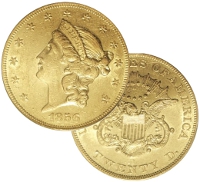

Tips for Buying and Selling Coins at Auction
Many collectors don't take into consideration all the costs and fees that take a bite out of the value of their collection when they buy and sell coins. Rare coin collecting is a lot like investing in many mutual funds. There are the equivalents of very large front-end loads, 12b-1 fees, and very large back-end loads.
This article takes a look at some of these fees as they relate to buying and selling coins, and how you can minimize or even eliminate some of them.
Buying and Selling Coins at Auction
With the growth of the internet and online coin auctions, it seems that many collectors are building their collections via these auctions. More and more collectors are buying very expensive coins without having even seen the coin in person. They are relying on digital photos to determine a coin's condition and eye appeal. So let's take a look at how these auctions work.
 |
1856-O $20 Gold Double Eagle PCGS AU55 |
| Heritage Auction July 28, 2005 |
|
Hammer Price: $375,000 Buyer's Fee (15%): $56,250 Final Price to Buyer: $431,250 |
Front-end Loads (aka Buyer's Fees)
When buying coins at auction, the front-end load is equivalent to the buyer's fee, usually about 15%. There's pretty much no way around the buyer's fee. Would you invest in a mutual fund with a front-end load of 15%?
If the coin appreciates 15% a year, you can expect to at least break even if you sell it after one year, right? Well, not so fast. That's assuming the hammer price you paid at auction (final price minus the buyer's fee) was a fair price for the coin. Did you and another bidder get caught up in the excitement and bid the coin too high? Afterall, you were the ONLY person willing to go that high during the auction. The simple fact is, you may have paid too much for the coin.
One way to avoid overbidding is to get a trusted dealer to represent you at auction. One drawback is that they will charge a fee thereby increasing your front-end load. The positives are that the dealer can view the coin before bidding and let you know their opinion of what the coin is worth. I've had more than one occasion where the coin looked fine online only to get a call from the dealer telling me there was something wrong with the coin and not to bid at all.
As for the fee, the industry standard is usually 5% of the final hammer price. I say "usually" because I've dealt with a dealer that charged me 12% above the hammer price on the final coin I needed to complete a set I was building. The dealer knew how bad I wanted the coin and may have taken advantage of that fact. I didn't know at the time that other dealers would have only charged me 5%. A costly lesson! Needless to say, I don't have that dealer represent me at auction anymore.
12b-1 Fees (aka safe deposit box, coin collection insurance)
These are what I call the hidden fees. They are the costs of holding your collection. If your collection is small, then you might not have any of these costs. But if your collection is large and high value, then you probably do have these fees.
The first is safety depost box rentals. At one point, my collection was so large that I had to store it in three separate safety deposit boxes. This was costing me around $250 a year. On a high value collection, this cost may be insignificant, but on a smaller value collection it may have more of an impact.
The more significant cost is insurance. My homeowner's policy didn't cover my collection so I had to get a separate policy specifically to cover the coins. For higher value collections, this could run into the thousands of dollars a year. One way to keep the cost down is to only have "vault" insurance. This means that your collection is only insured while it is in the safety deposit box. While this may lower your insurance cost, the problem is that you are uninsured any time you take the collection home. . . .